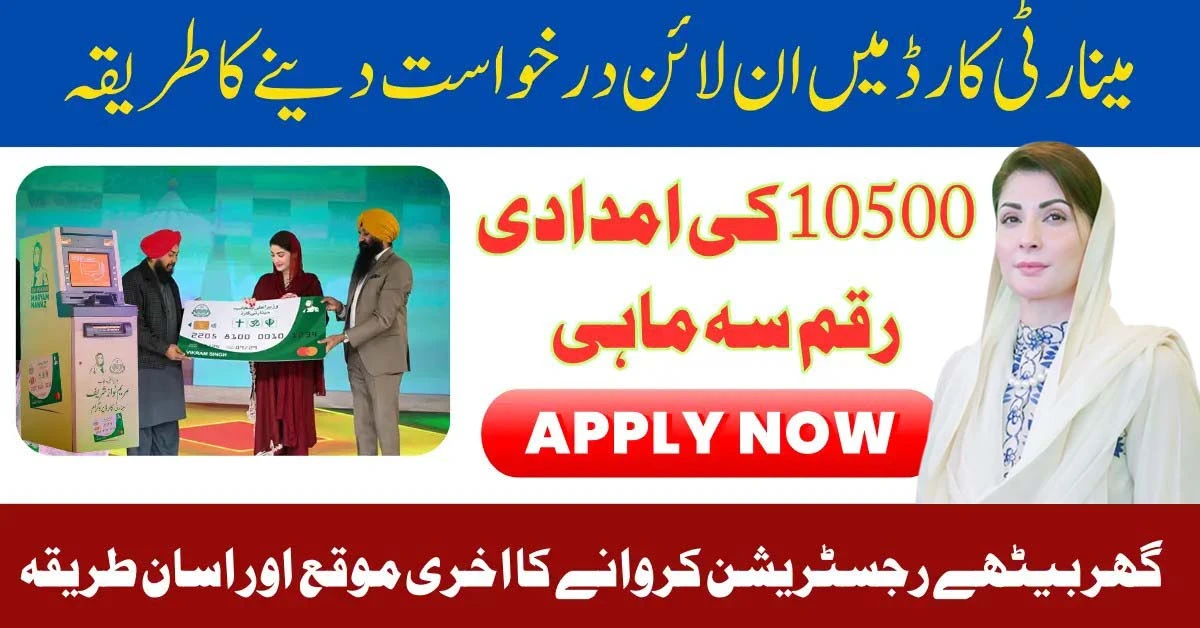In a groundbreaking move, Punjab Chief Minister Maryam Nawaz Sharif recently unveiled Pakistan’s first-ever ‘Chief Minister Minority Welfare Card’. The initiative, aimed at empowering minority communities, ensures financial stability and inclusion for thousands of families across the province.
During the launch event held at the Aiwan-e-Iqbal Complex in Lahore, Maryam Nawaz reaffirmed the government’s commitment to protecting and uplifting minority groups, including Hindus, Sikhs, Christians, and others. Here’s an in-depth look at the card’s benefits, eligibility criteria, and how to receive payments through it.
What Is the Minority Welfare Card?
The Minority Welfare Card is a social assistance program introduced by the Punjab government. It is designed to provide quarterly financial aid to minority families in need.
Initially, the program covers 50,000 families, each of whom will receive Rs 10,500 every three months. The initiative plans to expand the number of beneficiaries to 75,000 families in the near future.
The card symbolizes the Punjab government’s promise to uphold minority rights and ensure equitable development, reinforcing the message that minorities are integral to Pakistan’s progress.
Key Features of the Minority Welfare Card
- Quarterly Financial Support: Beneficiaries will receive Rs 10,500 every three months to assist with their daily needs.
- Increased Funding: The budget for minority welfare initiatives has been significantly increased, with plans to raise financial aid and expand the program.
- Inclusive Approach: The card aims to support individuals across various minority communities, regardless of gender or age.
- Development Initiatives: Alongside financial aid, the program includes plans to develop minority neighborhoods and religious sites.
Who Is Eligible for the Welfare Card?
The Minority Welfare Card is specifically targeted at underprivileged families from Punjab’s minority communities. Here’s a breakdown of the eligibility criteria:
- Community: The program is open to Hindus, Sikhs, Christians, and other recognized minority groups in Punjab.
- Income Level: Families with low incomes or in need of financial support are eligible.
- Residence: Applicants must be residents of Punjab.
How to Apply for the Minority Welfare Card
Applying for the Minority Welfare Card is a straightforward process. Here’s what you need to do:
- Visit Your Local Minority Affairs Office: Collect the application form from your district’s Minority Affairs Department.
- Provide Necessary Documents: Submit proof of residence, income verification, and a valid CNIC (Computerized National Identity Card).
- Verification Process: Once your application is submitted, the authorities will verify your information to ensure eligibility.
- Card Distribution: Upon approval, you will be issued the Minority Welfare Card.
How to Use the Minority Welfare Card for Payments
Once you receive your card, accessing your financial aid is simple. Follow these steps to withdraw your funds:
- Locate an ATM: The Minority Welfare Card is linked to the Bank of Punjab. Use any Bank of Punjab ATM for transactions.
- Insert Your Card: Insert the card into the ATM and enter your unique PIN.
- Select ‘Cash Withdrawal’: Choose the cash withdrawal option and enter the desired amount (up to Rs 10,500 per quarter).
- Collect Your Cash: Take your cash, receipt, and card once the transaction is complete.
Launch Ceremony Highlights
The official launch of the Minority Welfare Card was a grand event attended by leaders from various religious communities, including Hindus, Sikhs, and Christians.
- Prayers for Unity: Bishop Nadeem Kamran, Sardar Saranjit Singh, and Pandit Lal offered prayers for peace and harmony.
- ATM Demonstration: The Chief Minister personally oversaw a transaction by Sonia Bibi, showcasing how the card can be used for withdrawals.
- Recognition of Minorities: Maryam Nawaz emphasized that minorities are a vital part of Pakistan, referring to them as “symbols of pride” for the nation.
Also Read: CM Maryam Nawaz Introduces Minority Card with Rs. 10,500 Quarterly Payment
Government’s Vision for Minorities
During her speech, the Chief Minister highlighted the Punjab government’s ongoing efforts to support minority communities. Key points included:
- Increased Minority Development Budget: A 60% boost in the annual development budget for minority welfare.
- Improved Facilities: Upgrades to minority places of worship, including churches, temples, and gurdwaras.
- Special Grants on Festivals: Financial grants for festivals like Holi, Easter, and Christmas have been increased from Rs 10,000 to Rs 15,000.
- Community Projects: Projects such as new cemeteries for the Christian community and improved infrastructure for minority neighborhoods.
Conclusion
The launch of the Minority Welfare Card is a historic step toward empowering minority communities in Punjab. By providing financial assistance and addressing development needs, the initiative reaffirms the government’s commitment to inclusivity and equal opportunity.
Minorities are no longer just a part of Pakistan’s cultural mosaic; they are key contributors to its progress and prosperity. With programs like this, the Punjab government is ensuring that everyone, regardless of faith or background, feels valued and supported.
FAQs
1. Who is eligible for the Minority Welfare Card?
Families from minority communities in Punjab, such as Hindus, Sikhs, and Christians, with low incomes, are eligible.
2. How much financial aid is provided through the card?
Beneficiaries will receive Rs 10,500 every three months.
3. Where can I apply for the Minority Welfare Card?
Applications can be submitted at local Minority Affairs offices in Punjab.
4. How can I withdraw funds using the card?
You can use any Bank of Punjab ATM to withdraw the allocated amount.
5. Are there plans to expand the program?
Yes, the program aims to increase the number of beneficiaries from 50,000 to 75,000 families and enhance the financial aid provided.

